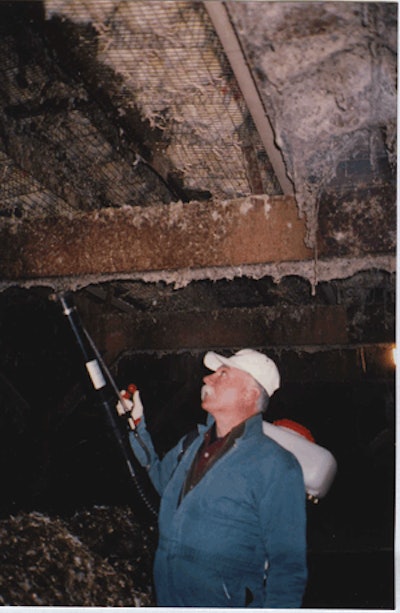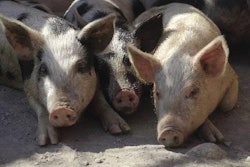
A natural pathogenic fungus — Beauveria bassiana — affecting only houseflies, is the basis of a new method to control fly populations in high-rise houses developed by Dr. Jim Arends, previously a faculty member and now an Adjunct Professor at North Carolina State University.
The product comprises a commercial suspension of Beauveria conidia, available as balEnce. The product is applied over manure cones and excreta adherent to cross beams using a commercial sprayer delivering a droplet size of 40 to 70 microns at a dose rate of 1 ounce of balEnce per 3,000 ft2 of floor area.
Generally, initial application on multi-age in-line units with fly problems should be carried out at least three times each week for four weeks followed by applications at 2-week intervals through fall and winter months. Intensity is increased to weekly application or more frequently in spring, with weekly application during summer months. A significant reduction in fly population most often occurs three weeks after initiating the program.
Contact with spores
Adult flies that emerge from their pupal cases come into contact which the spores (infectious stage of the life cycle) of Beauveria. Spores released from the conidia develop hyphae which penetrate into the body cavity of the flies resulting in death within days. Application of Beauveria is regarded as a component of an integrated control system which incorporates the contribution of beneficial insects and requires dry manure through appropriate ventilation and management of drinking systems. It is axiomatic that the use of synthetic pyrethrins temporarily suppresses fly populations but also destroys beneficial insects. Beauveria fungus has no detrimental effect on beneficial insects including Carcinops, beetles or Muscidifurax wasps which parasitize fly larva.
North Carolina study
A study was conducted on an in-line complex in North Carolina, based on favorable results as documented in a peer reviewed article (Kaufman et al. 2005, Evaluation of Beauveria bassiana Application Against the Adult House Fly, Musca domestica in Commercial Caged-Layer Poultry Facilities in New York State. Biological Control. 33: 360-367). The pit in the test house was treated with 2 x 108 Bassiana conida/10 ft2 in each of 14 applications over the experimental period, which extended from February 22 to April 7, 2008. The trial was terminated at this time due to the scheduled removal of all manure from the six houses on the site. The flock in the adjacent control house received a larvicide in feed to suppress fly breeding in manure but pyrethroid sprays and baits were not used.
Chart: balEnce vs. Standard treatment
Efficacy
The efficacy of the respective fly control procedures was evaluated using "sticky ribbons" which were unrolled and walked around the interior perimeter of the house prior to the initiation of the trial and on 11 sampling days extending from February 22 through April 7. Fly counts for the two houses are shown in the attached diagram.
It is projected that the cost of a comprehensive balEnce program would amount to $10,000 to $12,000 annually in comparison to $50,000 for a 10-house complex using conventional insecticides.


















